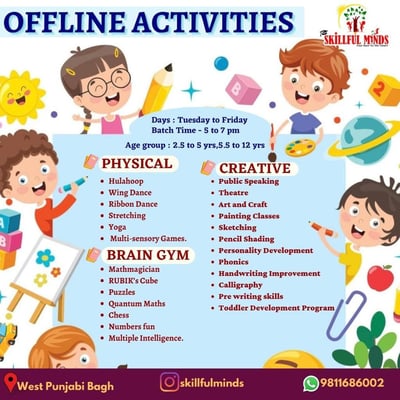Calligraphy classes for Kids - 80 options found
Calligraphy classes for children aged 2 to 15 offer numerous... Calligraphy classes for children aged 2 to 15 offer numerous benefits, including fine motor skill development, cognitive stimulation, artistic expression, language and literacy enhancement, and personal growth. Through focused practice and creative exploration, children refine their handwriting, cultivate attention to detail, and express themselves artistically. Calligraphy fosters confidence, patience, and perseverance as children master letter forms and experiment with different styles. These classes provide a creative outlet for self-expression and promote appreciation for aesthetics and design. By engaging in the art of beautiful handwriting, children develop valuable skills and confidence in their artistic abilities. Read more
skillful minds-offline activities
funscads-calligraphy classes
aaradhana kala kendra-dance class
learnways playschool-calligraphy class
funscads-calligraphy classes
prime educare-calligraphy writing
art by anupama-art & craft classes
Advantages of Calligraphy Classes for Children Ages 2 to 15
Introduction
Calligraphy classes offer children aged 2 to 15 an opportunity to explore the art of beautiful handwriting and creative expression. These classes provide numerous benefits, including cognitive development, fine motor skill refinement, artistic expression, and personal growth. In this guide, we will explore the advantages of calligraphy classes for children in this age range, along with addressing potential limitations and common questions.
Advantages
-
Fine Motor Skill Development:
- Hand-Eye Coordination: Calligraphy requires precise hand movements and control, enhancing hand-eye coordination as children learn to manipulate writing tools such as pens and brushes.
- Fine Motor Control: Practicing calligraphy improves fine motor skills as children develop control over their hand movements, strokes, and letter formations. Fine motor skill refinement is beneficial for handwriting, drawing, and other activities requiring dexterity.
-
Cognitive Benefits:
- Focus and Concentration: Calligraphy requires focused attention and concentration as children concentrate on creating intricate letterforms and designs. Practicing calligraphy enhances attention span and mindfulness.
- Memory and Creativity: Learning calligraphy involves memorizing letterforms, strokes, and techniques, stimulating memory recall and enhancing creativity as children experiment with different styles and compositions.
-
Artistic Expression:
- Creative Outlet: Calligraphy provides a creative outlet for self-expression as children experiment with different writing styles, flourishes, and decorations. Through calligraphy, children can express their thoughts, emotions, and personality in a visual and artistic manner.
- Aesthetic Appreciation: Learning calligraphy fosters an appreciation for aesthetics and design as children develop an eye for balance, proportion, and composition in their lettering and artwork.
-
Language and Literacy Skills:
- Letter Recognition: Practicing calligraphy reinforces letter recognition and reinforces familiarity with the alphabet and written language. Children develop a deeper understanding of letter shapes, structures, and connections.
- Handwriting Improvement: Calligraphy classes can improve children's handwriting by promoting consistency, legibility, and neatness in their letter formations. Calligraphic techniques can be applied to cursive and print handwriting styles.
-
Personal Growth:
- Confidence Boost: Mastering calligraphy builds children's confidence and self-esteem as they see improvements in their handwriting and artistic abilities. Positive reinforcement and encouragement from teachers and peers further enhance confidence.
- Patience and Perseverance: Learning calligraphy requires patience and perseverance as children practice and refine their skills over time. Through trial and error, children learn the value of practice, resilience, and continuous improvement.
Limitations
-
Age Appropriateness:
- Developmental Readiness: Younger children may lack the fine motor skills and attention span required for calligraphy, making it challenging for them to fully engage in the art form. Teachers must adapt instruction to accommodate the developmental needs of children in different age groups.
-
Resource Constraints:
- Access to Materials: Calligraphy classes may require specialized writing tools, paper, and ink, which may not be readily available to all students. Limited access to materials can constrain the types of projects and activities offered in calligraphy classes.
- Space and Facilities: Adequate space and facilities are needed for calligraphy instruction, including tables, chairs, and writing surfaces. Resource constraints may limit the availability of suitable learning environments for calligraphy classes.
-
Interest and Engagement:
- Varied Interest Levels: Not all children may be interested in or motivated to learn calligraphy. Teachers must find ways to engage students and make calligraphy classes enjoyable and meaningful for all learners, regardless of their initial interest level.
Common Questions
-
At What Age Should Children Start Calligraphy Classes?
- Children can begin learning calligraphy as early as elementary school, with age-appropriate instruction and activities tailored to their developmental stage. Younger children may start with simple letter formations and progress to more complex styles as they mature.
-
How Can Parents Support Their Children's Learning in Calligraphy?
- Parents can support their children's learning in calligraphy by providing access to writing materials such as pens, markers, and paper at home, encouraging regular practice, and praising effort and improvement. Attending calligraphy workshops or classes together can also be a fun bonding activity.
-
What Career Opportunities Are Available for Calligraphy Enthusiasts?
- While calligraphy may not lead to traditional career paths, individuals with advanced calligraphy skills can pursue opportunities in graphic design, illustration, typography, and hand lettering. Calligraphy enthusiasts may also offer commissioned work, teach workshops, or sell handmade goods.
-
Is Calligraphy Only for Those with Artistic Talent?
- No, calligraphy is a skill that can be learned and developed with practice and perseverance. While artistic talent may enhance one's calligraphy abilities, anyone can learn calligraphy with dedication and effort. Calligraphy classes provide instruction and guidance to help students improve their skills regardless of their initial talent level.
Conclusion
Calligraphy classes offer numerous advantages for children aged 2 to 15, including fine motor skill development, cognitive benefits, artistic expression, language and literacy skills, and personal growth. While there may be limitations related to age appropriateness, resource constraints, and interest levels, the benefits of calligraphy education outweigh the drawbacks. By providing opportunities for children to learn calligraphy in a supportive and encouraging environment, educators and parents empower children to develop their handwriting, artistic abilities, and confidence while cultivating a lifelong appreciation for the art of beautiful handwriting.
























